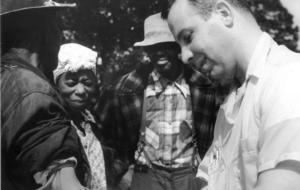The Tuskegee Experiment and the Foundations of Bioethics

The Tuskegee Experiment is one of those true stories where there are villains who seem to be drawn from some kind of insane imagination. The story also has its own hero, Peter Buxtun. He demonstrated an inspiring truth. The fact that it only takes one man to decide to do the right thing, and everything can change.
For many, the Tuskegee experiment was the longest and most infamous in the history of the United States. It was an experiment conducted with humans that lasted a total of 40 years. It began in 1932 and ended in 1972. In fact, this study proved that the Nazis weren’t the first or the only people to use human beings as objects of study in the laboratory.
The value of the Tuskegee experiment was that it marked a milestone in bioethics. While, until then, there was a certain legal framework in place to protect people who were the object of scientific studies, the rules were tightened and precautions increased when the scandal of this particular experiment came to light.
“Intellectual honesty is of the utmost importance in experimental work.”
-William Ian Beardmore Beveridge-

The Tuskegee Experiment
The Tuskegee experiment began in 1932 and was originally intended to study the effects of syphilis on those already infected with the disease. At that time, little was known about this infection and the available treatments were few and inefficient.
Dr. Taliaferro Clark, a member of the venereal disease section of the US Public Health Service in Tuskegee, Alabama, decided to observe the progress of the disease in infected and untreated individuals. The group of individuals he intended to observe, for six to eight months, was made up of poor black peasants, for the most part, illiterate.
Other prestigious doctors of the time also joined Clark’s study. Initially, 399 infected and 240 healthy men were recruited. The latter served as a control group.
To start with, all went according to plan but, a year later, Dr. Clark left the research team because he didn’t agree with the direction the study was taking.
The cracks in the experiment
From the beginning of the Tuskegee experiment, there were ethically questionable procedures. For instance, the subjects didn’t know the details of the research. Indeed, they were neither informed about what was going to be studied nor what methods would be used. In other words, there was no informed consent.
These people also didn’t receive a diagnosis, they were simply told that they had ‘bad blood’, a generic expression somewhat open to interpretation. Furthermore, they were encouraged to participate in the study with the promise of free medical treatment, free transportation to the clinic, food, and coverage of burial costs in the event of their death.
In practice, what was done with them was to let the disease evolve and observe its effects on their bodies. Finally, 600 people were studied. One of the most questionable points was the fact that, in the 1940s, scientists discovered that penicillin was effective against syphilis. However, they refused to give the drug to these individuals.
In addition, one doctor obtained the ‘volunteers” consent to carry out a certain procedure by advertising it as a ‘special free treatment’. The procedure was actually a lumbar puncture, a diagnostic test, not a treatment. One of the managers even congratulated his colleague for this message and praised his deceptive skills.

A hero and the end of a tragedy
Dr. Peter Buxton had come to the United States as a baby. His family had fled Czechoslovakia in fear of the Nazis. By 1966, he was a venereal disease researcher in San Francisco. That same year, he sent a letter to those in charge of the Tuskegee experiment expressing the serious concerns he had about the morality of the study.
Buxtun received no response but continued to persist in his solitary struggle for the next eight years. Seeing that he wasn’t getting any results, he decided to go to the press. The story initially appeared in the Washington Star and, a day later, made the front page of the New York Times. So serious were the complaints that it took only one day for the Tuskegee experiment to end.
By the time the study ended, 28 of the ‘volunteers’ had died of the disease while another 100 suffered a poor quality of life from related complications. Furthermore, 40 of their wives had been infected and 19 children were born with congenital syphilis.
In 1997, President Bill Clinton publicly apologized to those affected. Hardly surprisingly, this experiment undermined the confidence of many Americans in public health services.
The Tuskegee Experiment is one of those true stories where there are villains who seem to be drawn from some kind of insane imagination. The story also has its own hero, Peter Buxtun. He demonstrated an inspiring truth. The fact that it only takes one man to decide to do the right thing, and everything can change.
For many, the Tuskegee experiment was the longest and most infamous in the history of the United States. It was an experiment conducted with humans that lasted a total of 40 years. It began in 1932 and ended in 1972. In fact, this study proved that the Nazis weren’t the first or the only people to use human beings as objects of study in the laboratory.
The value of the Tuskegee experiment was that it marked a milestone in bioethics. While, until then, there was a certain legal framework in place to protect people who were the object of scientific studies, the rules were tightened and precautions increased when the scandal of this particular experiment came to light.
“Intellectual honesty is of the utmost importance in experimental work.”
-William Ian Beardmore Beveridge-

The Tuskegee Experiment
The Tuskegee experiment began in 1932 and was originally intended to study the effects of syphilis on those already infected with the disease. At that time, little was known about this infection and the available treatments were few and inefficient.
Dr. Taliaferro Clark, a member of the venereal disease section of the US Public Health Service in Tuskegee, Alabama, decided to observe the progress of the disease in infected and untreated individuals. The group of individuals he intended to observe, for six to eight months, was made up of poor black peasants, for the most part, illiterate.
Other prestigious doctors of the time also joined Clark’s study. Initially, 399 infected and 240 healthy men were recruited. The latter served as a control group.
To start with, all went according to plan but, a year later, Dr. Clark left the research team because he didn’t agree with the direction the study was taking.
The cracks in the experiment
From the beginning of the Tuskegee experiment, there were ethically questionable procedures. For instance, the subjects didn’t know the details of the research. Indeed, they were neither informed about what was going to be studied nor what methods would be used. In other words, there was no informed consent.
These people also didn’t receive a diagnosis, they were simply told that they had ‘bad blood’, a generic expression somewhat open to interpretation. Furthermore, they were encouraged to participate in the study with the promise of free medical treatment, free transportation to the clinic, food, and coverage of burial costs in the event of their death.
In practice, what was done with them was to let the disease evolve and observe its effects on their bodies. Finally, 600 people were studied. One of the most questionable points was the fact that, in the 1940s, scientists discovered that penicillin was effective against syphilis. However, they refused to give the drug to these individuals.
In addition, one doctor obtained the ‘volunteers” consent to carry out a certain procedure by advertising it as a ‘special free treatment’. The procedure was actually a lumbar puncture, a diagnostic test, not a treatment. One of the managers even congratulated his colleague for this message and praised his deceptive skills.

A hero and the end of a tragedy
Dr. Peter Buxton had come to the United States as a baby. His family had fled Czechoslovakia in fear of the Nazis. By 1966, he was a venereal disease researcher in San Francisco. That same year, he sent a letter to those in charge of the Tuskegee experiment expressing the serious concerns he had about the morality of the study.
Buxtun received no response but continued to persist in his solitary struggle for the next eight years. Seeing that he wasn’t getting any results, he decided to go to the press. The story initially appeared in the Washington Star and, a day later, made the front page of the New York Times. So serious were the complaints that it took only one day for the Tuskegee experiment to end.
By the time the study ended, 28 of the ‘volunteers’ had died of the disease while another 100 suffered a poor quality of life from related complications. Furthermore, 40 of their wives had been infected and 19 children were born with congenital syphilis.
In 1997, President Bill Clinton publicly apologized to those affected. Hardly surprisingly, this experiment undermined the confidence of many Americans in public health services.
All cited sources were thoroughly reviewed by our team to ensure their quality, reliability, currency, and validity. The bibliography of this article was considered reliable and of academic or scientific accuracy.
Cañizo Fernández-Roldán, A. D. El experimento Tuskegee/Miss Ever’s Boys (1997). Estudio de la evolución de la sífilis en pacientes negros no tratados.
This text is provided for informational purposes only and does not replace consultation with a professional. If in doubt, consult your specialist.







